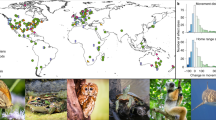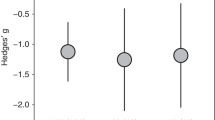Abstract
Humans have caused immense disturbances to the Earth’s wild ecosystems. Here, I explain how these disturbances are impacting and altering the essential roles or functions of animals in these ecosystems. Population declines, as well as behavioural and morphological changes in animals as a response to disturbance, alters how organisms interact with each other. Since these interactions define an animal’s role in its habitat, such changes can have devastating impacts on the future of these ecosystems.
Similar content being viewed by others
Suggested Reading
K H Redford, The Empty Forest, BioScience, Vol.42, No.6, pp. 412–422, 1992.
K R McConkey and G O’Farrill, Cryptic function loss in animal populations, Trends in Ecology & Evolution, Vol.30, No.4, pp. 182–189, 2015.
J A Estes, A Burdin, and D F Doak, Sea otters, kelp forests, and the extinction of Steller’s sea cow, PNAS, Vol.113, No.4, pp. 880–885, 2016.
R D Harrison et al., Consequences of defaunation for a tropical tree community, Ecology Letters, Vol.16, No.5, pp. 687–694, 2013.
D A Croll, J L Maron, J A Estes, E M Danner, and G V Byrd, Introduced Predators Transform Subarctic Islands from Grassland to Tundra, Science, Vol.307, No.5717, pp. 1959–1961, 2005.
K R McConkey and D R Drake, Flying Foxes Cease to Function as Seed Dispersers Long Before They Become Rare, Ecology, Vol.87, No.2, pp. 271–276, 2006.
R Winfree, J W Fox, N M Williams, J R Reilly, and D P Cariveau, Abundance of common species, not species richness, drives delivery of a real-world ecosystem service, Ecology Letters, Vol.18, No.7, pp. 626–35, 2015.
K H Redford, J Berger, and S Zack, “Abundance as a conservation value,” Oryx, Vol.47, No.02, pp. 157–158, 2013.
S L Hamilton, S D Newsome, and J E Caselle, Dietary niche expansion of a kelp forest predator recovering from intense commercial exploitation, Ecology, Vol.95, No.1, pp. 164–172, 2014.
R Zwolak, How intraspecific variation in seed-dispersing animals matters for plants, Biol Rev Camb Philos Soc, Vol.93, No.2, pp. 897–913, 2018.
C Brittain, N Williams, C Kremen, and A-M Klein, Synergistic effects of non-Apis bees and honey bees for pollination services, Proceedings of the Royal Society B: Biological Sciences, Vol.280, No.1754, pp. 20122767–20122767, 2013.
D A Burkholder, M R Heithaus, J W Fourqurean, A Wirsing, and L M Dill, Patterns of top-down control in a seagrass ecosystem: could a roving apex predator induce a behaviour-mediated trophic cascade?, Journal of Animal Ecology, Vol.82, No.6, pp. 1192–1202, 2013.
M S Strickland, D Hawlena, A Reese, M A Bradford and O J Schmitz, Trophic cascade alters ecosystem carbon exchange, PNAS, Vol.110, No.27, pp. 11035–11038, 2013.
H T Davies-Mostert, M G L Mills and D W Macdonald, Hard boundaries influence African wild dogs’ diet and prey selection, Journal of Applied Ecology, Vol.50, No.6, pp. 1358–1366, 2013.
D Lewanzik and C C Voigt, Artificial light puts ecosystem services of frugivorous bats at risk, Journal of Applied Ecology, Vol.51, No.2, pp. 388–394, 2014.
C D Francis, N J Kleist, C P Ortega, A Cruz, Noise pollution alters ecological services: enhanced pollination and disrupted seed dispersal, Proceedings of the Royal Society B 279: DOI: https://doi.org/10.1098/rspb.2012.0230
J A Merkle, H S Robinson, P R Krausman, and P Alaback, Food availability and foraging near human developments by black bears, Journal of Mammalogy, Vol.94, No.2, pp. 378–385, 2013.
B T Barton and A R Ives, Direct and indirect effects of warming on aphids, their predators, and ant mutualists, Ecology, Vol.95, No.6, pp. 1479–1484, 2014.
J Babin-Fenske, M Anand, and Y Alarie, Rapid morphological change in stream beetle museum specimens correlates with climate change, Ecological Entomology, Vol.33, No.5, pp. 646–651, 2008.
J Sumner, C Moritz, and R Shine, Shrinking forest shrinks skink: morphological change in response to rainforest fragmentation in the prickly forest skink (Gnypetoscincus queenslandiae), Biological Conservation, Vol.91, No.2, pp. 159–167, 1999. Please include the article by TR Rao in Resonance last year on Trophic Cascades.
Acknowledgements
The author thanks Sindhu Radhakrishna for the suggestion of writing this general article, Georgina O’Farrill for discussing many of these ideas (and eventually publishing a paper), and Chandra Ramarao for useful comments on the article.
Author information
Authors and Affiliations
Corresponding author
Additional information
Kim McConkey is Adjunct Faculty at NIAS, Bengaluru. She works on plant-animal interactions in Asia and the impact of human disturbances on these interactions.
Rights and permissions
About this article
Cite this article
McConkey, K. Anthropogenic Disturbances. Reson 25, 677–689 (2020). https://doi.org/10.1007/s12045-020-0983-1
Published:
Issue Date:
DOI: https://doi.org/10.1007/s12045-020-0983-1




